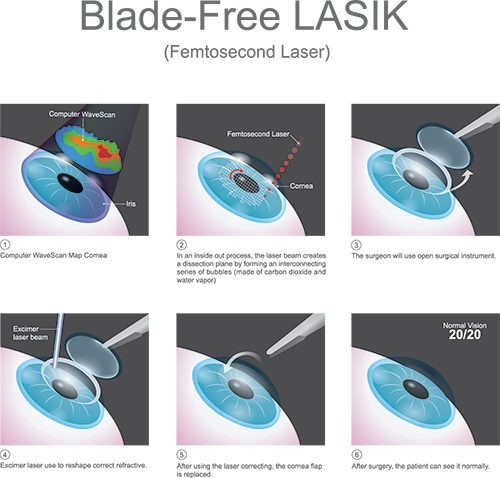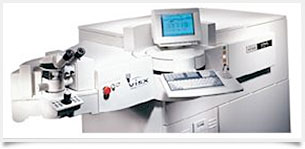Laser Vision Correction Overview
 Are you tired of wearing glasses or contacts?
Are you tired of wearing glasses or contacts?
Does your eyewear interfere with your daily activities?
Have you developed allergies or irritations from the use of eyewear?
These are just a few reasons people choose Laser Vision Correction – LASIK or PRK. Better vision, convenience and appearance are all important factors in today’s busy lifestyles. Please read on to learn more about these proven technologies and how they may be able to improve your lifestyle.
Any questions concerning the LASIK or PRK procedures? Check out our FAQ’s
Dr. Jovkar and our staff are involved in all aspects of patient care from the initial consultation, to performing the procedure, to follow-up care.
Dr. Jovkar and our staff are involved in all aspects of patient care from the initial consultation, to performing the procedure, to follow-up care.
There have been over 2 million laser vision procedures performed throughout the world. The unique features of the excimer laser beam allow computer-assisted accuracy to correct the refractive errors of the eye.
LASIK and PRK procedures are used to correct the following problems eye problems:
- Myopia (Nearsightedness)
- Hyperopia (Farsightedness)
- Astigmatism
There have been over 2 million laser vision procedures performed throughout the world. The unique features of the excimer laser beam allow computer-assisted accuracy to correct the refractive errors of the eye.
Technology
 The excimer laser is a highly precise instrument that produces and controls a powerful beam of cool laser light. The computerized excimer laser removes a microscopically small layer of tissue, sculpting the cornea to alter its curvature, improving the way light is focused through the cornea onto the retina, resulting in improved vision. By combining a mixture of Argon and Fluoride gases, the excimer laser works by exciting these gases electrically to produce a beam of cool light. The light is then emitted in pulses that last only a few billionths of a second. Each pulse determines how much tissue is removed.
The excimer laser is a highly precise instrument that produces and controls a powerful beam of cool laser light. The computerized excimer laser removes a microscopically small layer of tissue, sculpting the cornea to alter its curvature, improving the way light is focused through the cornea onto the retina, resulting in improved vision. By combining a mixture of Argon and Fluoride gases, the excimer laser works by exciting these gases electrically to produce a beam of cool light. The light is then emitted in pulses that last only a few billionths of a second. Each pulse determines how much tissue is removed.
Laser in-Situ Keratomileusis (LASIK)
About the LASIK Procedure
” I want to thank you personally for the excellent job you did on the laser surgery of my eyes. The time spent explaining the procedures was quiet appreciated and your staff was excellent before and after the surgery.”
– R.F.
Since the late 1970’s, incisional refractive surgery (RK) has treated nearsightedness and astigmatism in patients all over the world, allowing them to experience a new kind of freedom. It is the kind of freedom that allows people to make lifestyle choices that were not options to them before because they were totally dependent on glasses or contact lenses.
Now, refractive surgery is experiencing the dawning of a new era with the advent of the excimer laser, with the FDA approval of photo-refractive keratectomy (PRK) in 1995. Laser in-Situ Keratomileusis or LASIK, could represent another important step towards reducing dependence on corrective lenses.
LASIK combines the precision of the excimer laser delivery system with the benefits of Lamellar Keratoplasty (LK) to treat a wide range of refractive errors.
Photo-Refractive Keratectomy (PRK)
Photo-Refractive Keratectomy (PRK) uses the excimer laser (the same laser used in LASIK) to reshape the cornea. This surgical procedure is painless. Treatment is performed on the surface of the cornea in PRK rather than under a flap of corneal tissue as in LASIK. The laser is programmed to correct myopia, hyperopia and astigmatism. A contact lens is then in place for a few days while the corneal epithelium heals. Steroid drops are used for a period of time afterwards.
PRK should not be confused with the surgical procedure called Radial Keratotomy (RK), which is also used to correct nearsightedness.
RK involves surgical incisions deep into the cornea and relies on the manual skill of the surgeon. In contrast, PRK correction utilizes the micro-precision of a computer controlled excimer laser to reshape the cornea. Because of the greater accuracy of PRK and LASIK, RK is not performed as much anymore.
Because no incisions are made, PRK does not weaken the structure of your cornea. In most cases, PRK is performed as an outpatient procedure in the comfort and convenience of an excimer surgical suite.
The procedure is performed using an “eye-drop” anesthesia. Patients report some discomfort after the procedure until the outer portion of the cornea heals, usually within 48 to 72 hours. Some patients see a dramatic improvement in their vision within the first day, while others vision may be blurry and fluctuate for several weeks to several months. Most patients return to normal activities within one to three days
Any questions concerning the LASIK or PRK procedures? Check out our FAQ’s
Procedure
The LASIK procedure combines two sophisticated techniques to correct nearsightedness and/or astigmatism.
The first technique involves the use of an automated instrument, the microkeratome, to create a thin protective layer of corneal tissue (flap) that covers the area to be sculpted by the laser. This flap allows for rapid recovery of vision and reduces discomfort after the procedure.
The second technique uses the excimer laser to sculpt the underlying cornea, correcting the refractive error. This is the same laser that is used in PRK. The eye is not patched, but a protective shield is placed over the eye to prevent inadvertent rubbing of the eye. Visual recovery is typically rapid, and there is little or no post-operative pain. Eye drops, including an antibiotic to guard against infection, are taken for a week.
LASIK Procedure Steps
Suction Ring
After topical anesthetic eye drops are placed in the eye to minimize sensation, the eyelids are secured in the open position using a lid speculum. The eye is then stabilized with a suction ring which fits snugly on the eye. This allows the cornea to protrude through the hole in preparation for the microkeratome. You will not feel pain during this stage, however, vision will darken during the time the suction is applied and there may be a slight pressure sensation.
Microkeratome
Next, the microkeratome is placed into the grooves on the ring, and the gears are lined up. A thin flap is created with a “hinge.” This hinge allows the flap to stay in the correct position after the laser ablation.
Excimer Laser
With the flap folded back, the excimer laser removes an exact pre-determined amount of tissue from the center of the cornea. The computer controls the amount of laser treatment based on your prescription. During this stage, your surgeon will ask you to look at a blinking red light to allow proper alignment of the laser as it is focused on the corneal surface.
Flap Replacement
Lastly, the flap is returned to its original position where it quickly begins to adhere to the underlying tissue (stroma). It is allowed to air dry for approximately 2 minutes. There is usually no need for sutures.
Advantages
Rapid Recovery
Most patients are back to work in one day. There is typically very little or no pain, and patients recover vision within the first 24 hours, because the epithelial surface is minimally disrupted. RK & PRK are more uncomfortable and visual recovery usually takes longer.
Correction of a Full Range of Myopia / Astigmatism
Among the three procedures available for treating refractive errors (RK, PRK & LASIK), LASIK may be able to treat higher degrees of nearsightedness & astigmatism.
No Need for Long Term Eye Drops
There is no need to suppress wound healing with the use of steroids as there is with PRK.
Disadvantages
Requires a Skillful Surgeon
Because of the complexity of the microkeratome, manual dexterity and operative experience is required.
Go To Top
Cost
The equipment used is expensive and costly to maintain, making LASIK more expensive than PRK.
Increased Risks During the Procedure
Because of the microkeratome, there is increased chance of complications during the procedure than PRK.
Complications
LASIK is definitely a more complex procedure with respect to both equipment and performance of the procedure itself. The surgeon’s experience and refractive expertise is much more important. As with any surgical procedure – complications may arise.
Refractive surgery is elective – not everyone chooses to accept the small chance of a complication and the outcome of surgery can not be guaranteed for an individual patient. Dr. Jovkar will perform the appropriate preoperative tests to determine if you are a candidate and answer any questions you have regarding all refractive procedures available for nearsightedness, astigmatism and farsightedness. Ultimately, the decision to have refractive surgery is yours, and discussing all your questions and concerns with Dr. Jovkar will allow you to make an informed decision.
Please call us to schedule an evaluation of your individual needs at (408) 985-2020. You will meet personally with Dr. Jovkar to discuss your questions.
